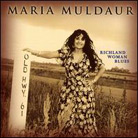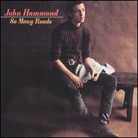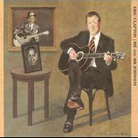![[SoundStage!]](../sslogo3.gif) The Vinyl Word The Vinyl WordBack Issue Article |
June 2004 Found on Vinyl: Maria Muldaur, John Hammond and Eric Clapton Surprise, surprise. Here are three new blues LPs, and not one of them is from that bastion of modern blues recordings, Analogue Productions. Amazing, isn’t it? Instead, these albums come from different sources: Grooveland, Cisco and Reprise Records. And for another shocker, each of these is, in its own way, a must-own record for anyone with even the slightest taste for the blues. I reviewed Maria Muldaur’s Richland Woman Blues [Grooveland GLS 108] in its initial Stony Plains CD release. I can well remember how taken I was with the basic blues concept of that CD, along with the superb sonics. But as good as that CD sounded -- and it sounded very, very good -- it doesn’t hold a candle to the sound of this Grooveland 180-gram double LP. Yep, it’s a two-fer -- one LP is the straight 33 1/3-rpm reissue of the CD, and the other is a 12" 45 rpm with four cuts from the album. And, as one would (and should) expect from today’s modern reissue houses, the LPs are dead flat, silent as the grave, and almost eerily real-sounding.
My two favorite moments are Muldaur's duet with Sebastian on the title track, and "Me and My Chauffeur Blues" with Roy Rogers, a tune that is also on the bonus 45. All songs are acoustic in nature, which lends itself very nicely to the added resolution of this LP. I was impressed with the sonics of the CD, but that left me totally unprepared for the improvement that the vinyl demonstrated. No digital, not even SACD or DVD-A, can match the quality of a well-recorded and -mastered LP. And no 33 1/3-rpm LP can touch a good 45 for sonic realism, as demonstrated by the tracks on the one included here. The 45's presence allows for easy side-by-side comparisons between the two playback speeds. Despite the shorter playing times -- and that’s a 45’s greatest drawback -- nothing gets you closer to the sound of live music than a good 45.
Hammond’s love for, and desire to keep alive, the classic blues of Dixon, Howlin’ Wolf, Waters, Johnson, and others has been well documented. As proof, today, almost 40 years after this album was recorded, Hammond is still out on the road or in the studio performing the blues. In 1965 Hammond was a mere 23 when he laid down these tracks. Yet, even now, this album still sounds as fresh as it did the day it rolled off the presses. There’s an honesty to the musicianship on So Many Roads that can only be explained by the love and knowledge these musicians, and especially Hammond, have for the blues. And it won’t matter which side of the album you decide to start with, as both begin in rousing fashion. Side one kicks off with the Willie Dixon tune "Down in the Bottom," featuring a wondrous guitar break with Hammond and Robertson. Side two starts with Hammond’s cover of Robert Johnson’s "Rambling Blues." As a matter of fact, there’s not a clunker in the bunch. It’s fun to listen to each of the back-up musicians -- Musselwhite’s harmonica and Helm’s drums, for instance, on the song "Who Do You Love." And Garth Hudson’s organ and Michael Bloomfield’s piano (yep, Bloomfield, who would make his name as a blues guitarist, is playing piano here) are always in the background, filling out each and every song. As for the record itself, Cisco has pulled out all the stops in reissuing this LP. From the down-to-the-last-detail cover art to the facsimile of the original Vanguard center label, this record oozes class. But the platitudes don’t stop there. Cisco also did one hellacious mastering and pressing job. This LP reproduces the sound of the master tapes with stunning fidelity. Hammond’s rough'n'ready, world-weary voice (all the more impressive given his age at the time) is very well rendered, and listening to the backing group play is almost as much fun as listening to Hammond sing. You can pick a line and follow it until either your patience ends (doubtful) or the song runs out (probable). Should this album be your initial introduction to Cisco’s vinyl portfolio (as it was mine), be prepared to have your bank account severely depleted. If Cisco's other LPs are anything close to as good as So Many Roads, there’s a whole lot of superb music out there awaiting us. (And let me just add that Cisco’s releases of albums by both Joan Baez and Doc Watson look to be on par with the Hammond.) Few musicians are as well known in both the blues and rock universes as Eric Clapton. As is the case with Muldaur and Hammond, Clapton’s fondness for the blues is equally well known. His desire to play the blues was (and still is) so strong that at certain points in his career he was willing to forgo rock stardom to play the music he loves (though it never quite came down to that in the end). And few of his albums have been anticipated with quite the fervor that his latest, Me And Mr. Johnson [Reprise LP 484234], has been. Its CD release was cause for much joy among his legion of fans. But what about those Clapton fans who embrace vinyl? Well, they’ve not been forgotten, as both Reprise and Classic Records have released pressings. Reprise’s -- the subject here -- is on 140-gram vinyl, and Classic’s is on a new 200-gram formula. An interesting side note to these dual issues: The standard-issue Reprise version comes complete with an oval sticker that says "Classic Records - Regular Weight - 140 gram" attached to the shrink wrap and Classic’s "Win A Free Test Pressing" postcard inside. Classic Records has verified that they really did press both versions at RTI; so the fact that the standard-issue vinyl is flat and fairly quiet (though nowhere near as quiet as any of Classic’s 200-gram LPs I’ve heard) comes as no surprise. It’s also about half the price of the 200-gram version, so it’ll be up to you whether or not to pony up for the thicker vinyl.
Another discomforting thing is a slight distortion in Clapton’s vocals at the beginning of some verses. This may be a problem with my pressing only, or it may be endemic of all the 140-gram pressings. I can’t say. It does speak for the 200-gram Classic LP as the issue of choice. Also, if you’re hyper allergic to surface noise, then the 140-gram pressing isn’t for you. It’s not that the noise will disturb the music -- it doesn’t -- but it is there and can be heard between cuts. Enough of the nits -- it’s the music that’s really important, and Me And Mr. Johnson contains some absolutely superb blues. I really connected with Clapton’s versions of "Me and the Devil Blues" and "Come on in My Kitchen." That Clapton loves the blues is evident, but also front and center is how well, even after all these years, he can play guitar. No longer feeling the need to play every note possible, Clapton now understands that less is sometimes more. Richland Woman Blues, So Many Roads and Me And Mr. Johnson are all excellent examples of modern blues. And each is a record that blues lovers will want to add to their collections. But, if you even have only a slight interest in the genre, you’ll still find much to like on these records, especially because the blues is the foundation of much of the music we listen to today, from rock to jazz. The 21st-century blues revival is not only underway, but running on all cylinders. Jump on and enjoy the ride. ...John Crossett
|
|
![[SoundStage!]](../sslogo3.gif) All Contents All ContentsCopyright © 2004 SoundStage! All Rights Reserved |
 For those of you
who are not familiar with my review of the musical content of Richland Woman Blues,
allow me to reiterate. This recording showcases Maria Muldaur’s wonderful voice along
with her way with a blues song in about as basic a setting as is possible. Most cuts
feature just Muldaur and one companion (occasionally bassist Roly Salley is added to make
it a trio). Joining Muldaur are, in no particular order, musicians such as John Sebastian,
Bonnie Raitt, Dave Mathews, Roy Rogers, Alvin Youngblood Hart and Taj Mahal. The settings
are almost stark in their simplicity. And the songs Muldaur chooses to interpret come from
the blues women and men who have inspired her over the years, such as Memphis Minnie (to
whom this album is dedicated), Bessie Smith, Rev. Gary Davis, Mississippi John Hurt and
Blind Willie Johnson, among others.
For those of you
who are not familiar with my review of the musical content of Richland Woman Blues,
allow me to reiterate. This recording showcases Maria Muldaur’s wonderful voice along
with her way with a blues song in about as basic a setting as is possible. Most cuts
feature just Muldaur and one companion (occasionally bassist Roly Salley is added to make
it a trio). Joining Muldaur are, in no particular order, musicians such as John Sebastian,
Bonnie Raitt, Dave Mathews, Roy Rogers, Alvin Youngblood Hart and Taj Mahal. The settings
are almost stark in their simplicity. And the songs Muldaur chooses to interpret come from
the blues women and men who have inspired her over the years, such as Memphis Minnie (to
whom this album is dedicated), Bessie Smith, Rev. Gary Davis, Mississippi John Hurt and
Blind Willie Johnson, among others. Second up is Cisco’s
reissue of one of John Hammond’s best Vanguard records, the 1965 classic So Many
Roads [Cisco VSD79173]. This album is notable for two very different but very special
reasons. First, it showcases Hammond singing the songs of some of his greatest blues
heroes -- Muddy Waters, Willie Dixon, Robert Johnson, and others -- recorded in very good
sound. Second, his support group is made up of -- get this -- Robbie Robertson, Levon
Helm, Garth Hudson (before they joined together in some fly-by-night group called The
Band), Charlie Musselwhite, and Mike Bloomfield. It wouldn’t be too many more years
before each of these musicians was a star unto himself.
Second up is Cisco’s
reissue of one of John Hammond’s best Vanguard records, the 1965 classic So Many
Roads [Cisco VSD79173]. This album is notable for two very different but very special
reasons. First, it showcases Hammond singing the songs of some of his greatest blues
heroes -- Muddy Waters, Willie Dixon, Robert Johnson, and others -- recorded in very good
sound. Second, his support group is made up of -- get this -- Robbie Robertson, Levon
Helm, Garth Hudson (before they joined together in some fly-by-night group called The
Band), Charlie Musselwhite, and Mike Bloomfield. It wouldn’t be too many more years
before each of these musicians was a star unto himself. Me And Mr. Johnson is Clapton’s homage to the
music of the man considered by many to define the entire blues genre, Robert Johnson. But
one thing this album is not is an acoustic blues album. Clapton takes Johnson
uptown, to, let's say, Chicago. While this album can in no way be considered an accurate
reproduction of Johnson’s music, it is highly involving and entertaining. And there
is quite a group of backing musicians aiding Clapton here: Billy Preston on keyboards,
Steve Gadd on drums, Nathan East on bass, Andy Fairweather Low and Doyle Bramhall II on
guitars, and Jerry Portnoy on harmonica. Together, they reinterpret 14 of Johnson’s
songs. But that’s part of the problem with this disc. There’s a bit too much
music crammed onto each side -- about 25 minutes worth, at least two and a half too many
for comfort. Still, the sound is enjoyable and fairly clear, if a bit lightweight
bass-wise.
Me And Mr. Johnson is Clapton’s homage to the
music of the man considered by many to define the entire blues genre, Robert Johnson. But
one thing this album is not is an acoustic blues album. Clapton takes Johnson
uptown, to, let's say, Chicago. While this album can in no way be considered an accurate
reproduction of Johnson’s music, it is highly involving and entertaining. And there
is quite a group of backing musicians aiding Clapton here: Billy Preston on keyboards,
Steve Gadd on drums, Nathan East on bass, Andy Fairweather Low and Doyle Bramhall II on
guitars, and Jerry Portnoy on harmonica. Together, they reinterpret 14 of Johnson’s
songs. But that’s part of the problem with this disc. There’s a bit too much
music crammed onto each side -- about 25 minutes worth, at least two and a half too many
for comfort. Still, the sound is enjoyable and fairly clear, if a bit lightweight
bass-wise.